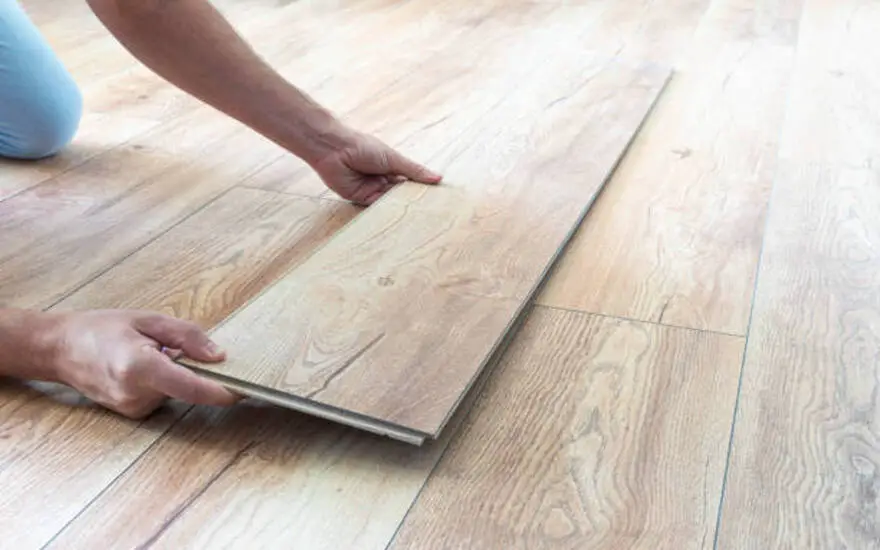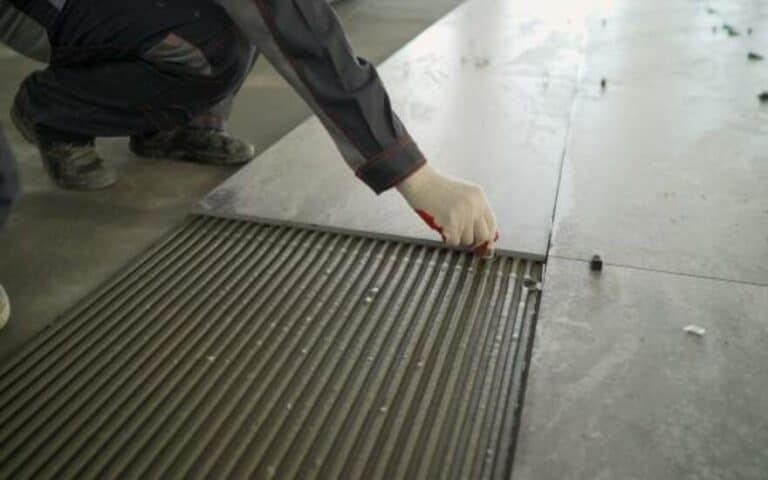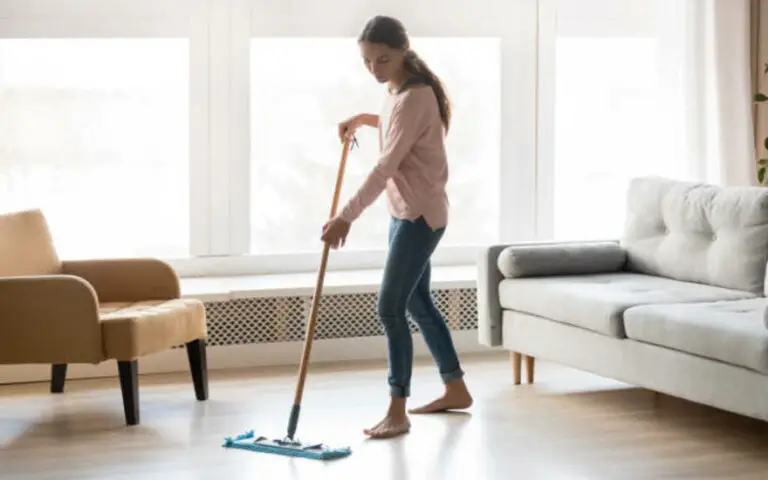While it’s an affordable and stylish option, there are some places where it’s not suitable. In this blog post, I’ll discuss which areas of your home should be avoided when installing laminate flooring.

8 Places should you not put laminate flooring
If you’re installing laminate flooring on stairs, you should use a special laminate specifically designed for staircases. If you notice any scratches or scuffs on your high gloss laminate floors, you should use a specially formulated cleaner to help remove them. When it comes to vinyl flooring, it needs to be attached securely with adhesive or grout to prevent any warping or damage over time.
1. Bathrooms
Regarding bathrooms, laminate flooring is not always the best option. While many people opt for laminate flooring for its water-resistant properties and durability, there are some important considerations to keep in mind.
Laminate flooring should not be installed in saunas, enclosed porches, or anywhere with high moisture levels. Additionally, it is important to use the correct type of underlayment to ensure that the floor can withstand any water damage or imperfections in the subfloor.
And finally, it’s important to leave an expansion gap around the room’s perimeter when installing laminate floors to prevent warping and buckling over time. While laminate flooring can be a great option for some bathrooms, it is important to do your research and ensure you take all necessary precautions before installing it.
2. Laundry Rooms
When it comes to laundry rooms, laminate flooring isn’t the best option. It can be damaged easily by moisture, and water can seep into the joints, causing the floor to warp and buckle. If you use laminate flooring in your laundry room, leave an expansion gap and use a waterproof underlayment.
It would be best if you also were mindful of any imperfections on the floor – they could cause problems down the line. Additionally, it’s important to note that vinyl flooring is a better option for laundry rooms, as it is designed to be more water-resistant.
3. Saunas
When it comes to saunas, laminate flooring isn’t the best choice. While laminate flooring is a great option for many areas, it doesn’t fare well in a sauna. The heat and moisture of a sauna can cause the laminate to swell and warp, creating an unsafe environment. Instead of laminate flooring, you should opt for tiles or vinyl, as these are more resistant to heat and moisture in a sauna.
If you’re looking for a cheaper option, pressure-treated wood is another viable option for a sauna floor. It’s important to note that any flooring in a sauna should leave an expansion gap between the wall and the floor so that the floor won’t buckle when exposed to high temperatures.
4. Enclosed Porches
When installing laminate flooring on an enclosed porch, it’s best to avoid it. Since the porch is exposed to sunlight and temperature changes, the laminate will be prone to warping due to moisture. Instead, consider using carpet, ceramic, or vinyl flooring for this area.
These materials are better suited for withstanding the elements and can tolerate expansion and contraction with temperature changes. Be sure to leave an expansion gap around the perimeter of the flooring as well; this will help prevent damage from occurring due to humidity.
5. Underlayment
Underlayment is an important part of the laminate flooring installation process. It provides a layer between the damp subfloor and the surface flooring, protecting it from moisture damage and providing a cushion for more comfortable walking. Most laminate flooring requires an underlayment unless one is already attached to its bottom.
An underlayment is essential if the subfloor is concrete or another hard substance. For cold subfloors like concrete, you may also need a damp-proof membrane. With the right underlayment, your laminate flooring will stay in top condition for years.
6. Moisture
When installing laminate flooring, it’s important to consider moisture. High moisture content in the air can cause laminate flooring to become saturated, leading to buckling and other imperfections. For this reason, it’s best to avoid installing laminate flooring in bathrooms, laundry rooms, saunas, and enclosed porches.
It’s also important to use an underlayment to protect against moisture and ensure the longevity of your laminate flooring. Even with an underlayment, you should always check the moisture levels of a room before beginning any installation.
7. Floor Imperfections
When it comes to floor imperfections, you should not put laminate flooring in areas with cracks, holes, or uneven sub-floors. If you do, your laminate flooring may be subject to damage from the uneven subfloor.
Ensure any cracks, holes, or other imperfections are repaired, and the sub-floor is even before laying down your laminate flooring. It would be best if you also left an expansion gap around the edges and between pieces of laminate flooring to prevent buckling.
8. Carpet Underlayment
Carpet underlayment is a definite no-no when it comes to installing laminate flooring. While it may seem easy to cut costs, this type of carpet does not provide the stability needed for a laminate floor. Laminate floors usually require a thin insulation layer that’s much thinner than what carpet underlayment provides – so it’s best to avoid it altogether.
Additionally, some laminate flooring planks come with the underlayment already attached, and this is something you need to protect your new floor from moisture and imperfections. If your planks don’t have it, make sure you purchase the right underlayment, as not doing so can cause issues further down the line.
Do I need Laminate Flooring Underlayment?
Absolutely! Underlayment is a must-have for laminate flooring installations. It provides a layer between the subfloor and the surface flooring, preventing moisture from seeping in and warping your flooring.
It also provides extra cushioning and sound reduction. If you’re installing laminate in an area with a cold subfloor, like concrete, you may need to consider a damp-proof membrane to ensure your flooring is safe from moisture damage. So don’t skip out on the underlayment – it’s essential for a successful laminate floor installation!
What happens if I don’t leave an expansion gap?
If you don’t leave an expansion gap around the edges of your laminate flooring, you risk experiencing performance issues such as buckling and squeaking. This is because the expanding laminate floor has no gap to allow for movement, leading to the floorboards being forced upwards, which can create a bouncy effect in extreme cases.
As a result, ensuring a minimum of ¼ inch expansion gap around your laminate flooring is essential to prevent any issues.
Can Laminate Flooring be installed on stairs?
Yes, you can install laminate floorboards on stairs! It’s a great way to add a stylish and durable finish to your stairway. Laminate planks usually come in 7 inches wide, but the treads of stairs are usually 11 inches wide, so you’ll have to trim them down accordingly.
Start from the top step and work your way down for the best results. Make sure to use wood effect laminate boards instead of underlayment, and don’t forget to leave an expansion gap for best results. With the right materials, knowledge, and patience, you’ll be able to have beautiful laminate stairs in no time!
How do I remove scratches from high gloss laminate floors?
Removing scratches from high gloss laminate floors can be a frustrating task. Fortunately, there are a few easy solutions. For minor scratches, you can use a pencil eraser or the sole of a tennis shoe to lightly rub the area in a circular motion. To address deeper scratches, you can use WD-40 or toothpaste.
Dab the substance on the scratch and let it sit for several minutes before wiping it away. Once the scratches have been removed, clean up any remaining paste with water and vinegar. Just remember to avoid abrasive tools and materials that could cause more scratches!
How does vinyl flooring work?
When it comes to vinyl flooring, there are two main types: glue-down and floating. With glue-down vinyl, you attach the vinyl planks to the subfloor using adhesive. The planks are laid down and connected with floating vinyl but not attached to the subfloor. This is a great option for DIYers who don’t want to mess with adhesive.
No matter which type of flooring you choose, leaving an expansion gap around the room’s edges is important to prevent buckling from temperature changes. Additionally, you’ll need to ensure that your subfloor is level and smooth before installing your vinyl planks, as any imperfections could also cause buckling.
Summary
In summary, laminate flooring is a great choice for most rooms in your home. However, a few places are not recommended due to the risk of water damage or warping. Bathrooms, laundry rooms, and saunas are not good places to install laminate floors since they are usually exposed to large amounts of moisture.
Additionally, ensure you use underlayment when installing laminate flooring, as this will help protect the boards from moisture and provide a cushion against any imperfections in the floor underneath. Finally, remember to leave an expansion gap between the walls and the planks and use a damp mop for cleaning. With these tips in mind, you can enjoy your beautiful laminate flooring for years to come!





![How To Install Floating Vinyl Plank Flooring In A Bathroom [East Steps] 6 How To Install Floating Vinyl Plank Flooring In A Bathroom [East Steps]](https://homequeries.com/wp-content/uploads/2023/02/istockphoto-1423993715-612x612_880x550-768x480.jpg)
